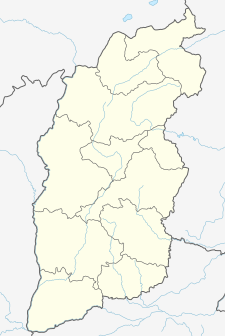| Bishan Temple | |
|---|---|
| 碧山寺 | |
 The paifang at Bishan Temple. The paifang at Bishan Temple. | |
| Religion | |
| Affiliation | Buddhism |
| Sect | Chan Buddhism |
| Location | |
| Location | Wutai County, Shanxi, China |
 | |
| Geographic coordinates | 39°01′46″N 113°36′48″E / 39.029336°N 113.613396°E / 39.029336; 113.613396 |
| Architecture | |
| Style | Chinese architecture |
| Date established | Emperor Xiaowen of Northern Wei (467-499) |
The Bishan Temple or Guangji Maopeng (Chinese: 碧山寺; pinyin: Bìshān Sì or simplified Chinese: 广济茅蓬; traditional Chinese: 廣濟茅蓬; pinyin: Guǎngjì Máopéng) is a Buddhist temple located in Taihuai Town of Wutai County, Xinzhou, Shanxi, China.
History
In the Qingliangshan Annals, a poem described Bishan Temple as "落日碧山寺,萧然古涧边,白云生翠崦,明月下寒泉。".
Baiyun Temple was first established in the reign of Emperor Xiaowen of Northern Wei (467-499) and initially called "Beishan Temple" (北山寺).
In the period of Emperor Yingzong of Ming (1435-1449 and 1457-1464) in the Ming dynasty (1368-1644), it was renamed "Puji Temple" (普济寺).
In the reign of the Qianlong Emperor (1711-1799), because the temple is surrounded by mountains, it is also called Bishan Temple. Later in the reign of Emperor Xuantong (1908-1912), it was also named "Guangji Maopeng" (广济茅蓬).
In 1983 it has been designated as a "National Key Buddhist Temples in Han Chinese Area".
On August 26, 2017, master Dayun (达云法师), a student of Chan master Miaojiang (妙江长老) served as abbot of Biyun Temple.
Architecture
Paifang
Under the paifang is a horizontal inscribed board with the Chinese characters "清凉震萃". A wooden plaque with a couplet is hung on the two side pillars. It says "敷演清凉,四时瑞雪常飘,幻出银装世界。恢宏极乐,六月莲花始放,翻成金色乾坤。".
Hall of Four Heavenly Kings
Maitreya is enshrined in the Hall of Four Heavenly Kings and at the back of his statue is a statue of Skanda. Statues of Four Heavenly Kings stand on the left and right sides.
Pilu Hall
The Pilu Hall (毗卢殿), also known as "Leiyin Baodian" (雷音宝殿), in the middle is Pilu Buddha (毗盧佛), the twelve Bodhisattva stand on the platform of gable wall. On the left, from back to front, they are statues of Miaode, Puyan, Maitreya, Weide Zizai, Jingzhu Yezhang and Yuanjue (妙德、普眼、弥勒、威德自在、净诸业障、圆觉六菩萨). On the right, from back to front, they are statues of Samantabhadra, Jingangzang, Qingjinghui, Bianyin, Pujue and Xianshan (普贤、金刚藏、清净慧、辩音、普觉、贤善首六菩萨). A pair of Buddha's warrior stand on both sides of the gate.
Zhaobi
The Zhaobi (照壁) is built by stones and bricks. A Chinese poem is carved in the Zhaobi. It reads: "眼错不辨天花落,口说前朝事可凭,铁棒五郎曾护驾,铜台大显五台僧。"
Jietan Hall (Hall of Ordination Altar)
Jietan Hall (Hall of Ordination Altar), the most important hall in the temple, is the third hall of the temple. A large square ordination altar (戒坛) which is 5.1 metres (17 ft) long, 5 metres (16 ft) wide and 1.2 metres (3 ft 11 in) high and made of bluestone is placed in the middle of the hall. The present ordination altar was built in the Ming dynasty (1368-1644). A sitting statue of Sakyamni which was brought from Burma in 1928 stands on the ordination altar. Both sides of the statue enshrine the Eighteen Arhats, they were made in the Shunzhi period (1644-1661) of Qing dynasty (1644-1912).
Buddhist Texts Library
The Buddhist Texts Library is a two-story wooden structure. The sitting statue of Maitreya is placed with his head to the two-story.
References
- 碧山寺 [Bishan Temple]. chinawts.com (in Chinese). 2005. Archived from the original on 2018-02-17. Retrieved 2017-12-17.
- 五台山这座驰名中外的寺院迎来第六代方丈 它有着怎样傲娇的历史. iFeng (in Chinese). 2017-08-25.
- ^ 五台山碧山寺 [Bishan Temple in Mount Wutai]. huaxia.com (in Chinese). 2015. Archived from the original on 2010-12-08. Retrieved 2017-12-17.
- 达云法师荣膺五台山碧山寺方丈升座庆典圆满举行. iFeng (in Chinese). 2017-08-26.